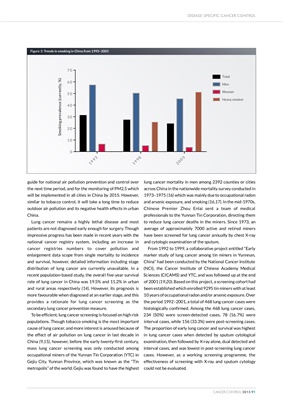
guide for national air pollution prevention and control over
the next time period, and for the monitoring of PM2.5 which
will be implemented in all cities in China by 2015. However,
similar to tobacco control, it will take a long time to reduce
outdoor air pollution and its negative health effects in urban
China.
Lung cancer remains a highly lethal disease and most
patients are not diagnosed early enough for surgery. Though
impressive progress has been made in recent years with the
national cancer registry system, including an increase in
cancer registries numbers to cover pollution and
enlargement data scope from single mortality to incidence
and survival, however, detailed information including stage
distribution of lung cancer are currently unavailable. In a
recent population-based study, the overall five-year survival
rate of lung cancer in China was 19.5% and 11.2% in urban
and rural areas respectively (14). However, its prognosis is
more favourable when diagnosed at an earlier stage, and this
provides a rationale for lung cancer screening as the
secondary lung cancer prevention measure.
To be efficient, lung cancer screening is focused on high risk
populations. Though tobacco smoking is the most important
cause of lung cancer, and more interest is aroused because of
the effect of air pollution on lung cancer in last decade in
China (9,15), however, before the early twenty-first century,
mass lung cancer screening was only conducted among
occupational miners of the Yunnan Tin Corporation (YTC) in
Gejiu City, Yunnan Province, which was known as the "Tin
metropolis" of the world. Gejiu was found to have the highest
lung cancer mortality in men among 2392 counties or cities
across China in the nationwide mortality survey conducted in
1973-1975 (16) which was mainly due to occupational radon
and arsenic exposure, and smoking (16,17). In the mid-1970s,
Chinese Premier Zhou Enlai sent a team of medical
professionals to the Yunnan Tin Corporation, directing them
to reduce lung cancer deaths in the miners. Since 1973, an
average of approximately 7000 active and retired miners
have been screened for lung cancer annually by chest X-ray
and cytologic examination of the sputum.
From 1992 to 1999, a collaborative project entitled "Early
marker study of lung cancer among tin miners in Yunnnan,
China" had been conducted by the National Cancer Institute
(NCI), the Cancer Institute of Chinese Academy Medical
Sciences (CICAMS) and YTC, and was followed up at the end
of 2001 (19,20). Based on this project, a screening cohort had
been established which enrolled 9295 tin miners with at least
10 years of occupational radon and/or arsenic exposure. Over
the period 1992-2001, a total of 468 lung cancer cases were
histologically confirmed. Among the 468 lung cancer cases,
234 (50%) were screen-detected cases, 78 (16.7%) were
interval cases, while 156 (33.3%) were post-screening cases.
The proportion of early lung cancer and survival was highest
in lung cancer cases when detected by sputum cytological
examination, then followed by X-ray alone, dual detected and
interval cases, and was lowest in post-screening lung cancer
cases. However, as a working screening programme, the
effectiveness of screening with X-ray and sputum cytology
could not be evaluated. DISEASE-SPECIFIC CANCER CONTROL
CANCER CONTROL 2015 91
Smoking prevalence (currently, %)
Total
Men
Women
Heavy smoker
1 9 9 3
1 9 9 8
2 0 0 3
0
10
2 0
30
40
5 0
60
70
Figure 3: Trends in smoking in China from 1993-2003